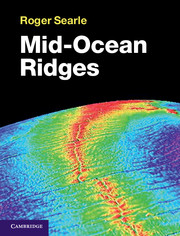Book contents
- Frontmatter
- Dedication
- Contents
- Preface
- 1 Introduction
- 2 Techniques of MOR study: a brief historical review
- 3 The oceanic lithosphere
- 4 Ridges as plate boundaries
- 5 Crustal structure and composition
- 6 Volcanism
- 7 Tectonism
- 8 Hydrothermal processes
- 9 Summary and synthesis
- Appendix A Glossary of terms
- Appendix B Directory of named features
- References
- Index
- Plate Section
9 - Summary and synthesis
Published online by Cambridge University Press: 05 June 2014
- Frontmatter
- Dedication
- Contents
- Preface
- 1 Introduction
- 2 Techniques of MOR study: a brief historical review
- 3 The oceanic lithosphere
- 4 Ridges as plate boundaries
- 5 Crustal structure and composition
- 6 Volcanism
- 7 Tectonism
- 8 Hydrothermal processes
- 9 Summary and synthesis
- Appendix A Glossary of terms
- Appendix B Directory of named features
- References
- Index
- Plate Section
Summary
Mid-ocean ridges are one of the three types of tectonic plate boundary, where lithosphere is continually created and spread away from the ridge axis. There are profound differences across the world in the details of the processes involved, although the basic principles are clearly linked. These differences are thought mostly to reflect differing degrees of melt produced in the mantle and ultimately delivered to the crust. A convenient but approximate proxy for mantle melting is the spreading rate: generally, greater melting occurs at faster spreading rates, because heat is advected faster there. There are some important departures from this simple association, which are not yet fully understood, although variations in mantle temperature probably play a part. Important too may be variable mantle fertility: virgin mantle melts easily, but the residual mantle left over from past melting, if again brought into the melting zone, will be harder to melt. This chapter first summarises features that are common to most ridges; Sections 9.2–9.5 summarise features apparently dependent on spreading rate; and finally Section 9.6 considered the anomalies.
Common features
Mid-ocean ridges (MORs) are the places where plates separate and new oceanic lithosphere is formed. As that lithosphere moves away from the ridge axis it ages, cools, becomes denser and less buoyant, and slowly sinks. Sea floor depth is proportional to the square root of age, as predicted by simple thermal cooling models. The forces driving plate separation derive partly from the ridge topography, which applies a pressure gradient tending to separate the plates (the ‘ridge-push’ force), and partly from far-field forces such as the weight of subducting lithosphere (‘slab-pull’). As plates age and cool they thicken and become stronger. The base of the lithosphere may be defined by the brittle–plastic transition, which is often approximated by the 750 °C isotherm. Thus plate thickness as well as depth increases as the square root of age, from a few kilometres at the ridge axis to tens of kilometres or more in old lithosphere.
- Type
- Chapter
- Information
- Mid-Ocean Ridges , pp. 231 - 238Publisher: Cambridge University PressPrint publication year: 2013



